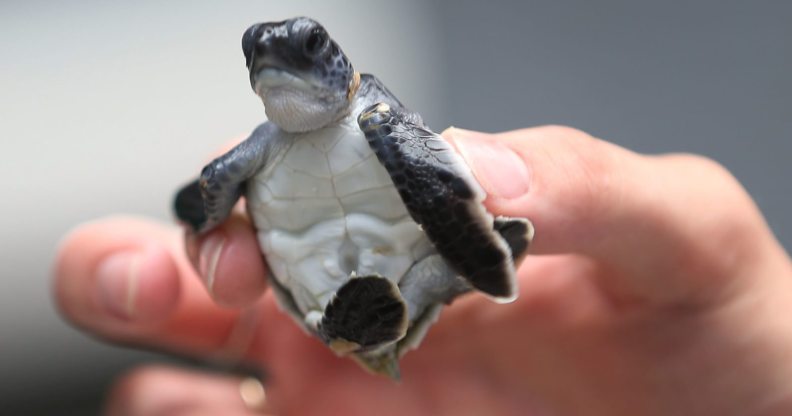Almost all the Great Barrier Reef sea turtles have turned female

A green turtle is held by marine turtle specialists (Photo by Joe Raedle/Getty Images)
A green turtle is held by marine turtle specialists (Photo by Joe Raedle/Getty Images)
A population of green sea turtles is turning almost entirely female due to changes in the environment, scientists have found.
Temperature change in the Great Barrier Reef is causing the turtles to turn from male to female.
The transformation has led scientists to be concerned about the species’ future – with just 0.2 per cent of the turtles being male in some areas.

Sea turtle (Getty)
Environment temperatures play a key role in determining the sex of green sea turtles.
The proportion of female hatchlings increases when nests are in warmer sands, while cooler temperatures is known to produce more male turtles.
For more than two decades the majority of newly-hatched sea turtles have been female, marine scientists say.
The ‘pivotal temperature’ that creates a 50/50 split of male and female can be passed down from parent to offspring.

Two-year-old Green Sea Turtle “Sea Biscuit” (Photo GREG WOOD/AFP/Getty Images)
Increased temperatures has caused many sea turtles to become female.
Genetic and hormone analysis of the turtles in the northern and southern parts of the Great Barrier Reef showed 99 percent of young sea turtles nesting on warmer northern beaches were female.
Green sea turtles are not the only creature to be affected like this.

A sea turtle hatchling swims (Photo Ishara S.KODIKARA/AFP/Getty Images)
Clownfish are all born male, with most dominant male of the group will become female.
The fish have one female per group, and if she died it is normally down to the largest male to become female and take her place.
Slugs also have varying identities: they are born with both female and male reproductive organs, which they use to mate simultaneously.
Some female snakes – such as the yellow-bellied water snake (Nerodia erythrogaster) – kept alone in captivity have given birth to litters of baby snakes.
Known as parthenogenesis, it’s a type of asexual reproduction and might have evolved as a last resort strategy when no males can be found.

Frog (Getty)
Frogs, too, are known to spontaneously change from female to male due to a chemical trigger that occurs when there are not enough males to reproduce.
As for the green sea turtles, scientists said: “Combining our results with temperature data show that the (warmer) northern GBR green turtle rookeries have been producing primarily females for more than two decades and that the complete feminisation of this population is possible in the near future.”
Researchers warned: “With warming global temperatures and most sea turtle populations naturally producing offspring above the pivotal temperature, it is clear that climate change poses a serious threat to the persistence of these populations.”
The research examined two genetically distinct populations of turtles on the reef, finding the northern group of about 200,000 animals was overwhelmingly female.
It is published in the journal Current Biology.

